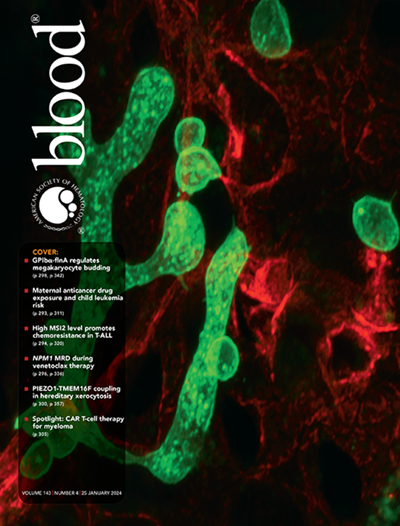A multiomic analysis of Waldenström macroglobulinemia defines distinct disease subtypes.
IF 21
1区 医学
Q1 HEMATOLOGY
引用次数: 0
Abstract
We carried out a single-cell (sc) multiomic analysis on a series of MYD88 mutated Waldenström macroglobulinemia (WM) cases and identified two distinct subtypes of disease, memory B-cell-like (MBC-like) and plasma cell-like (PC-like), based on their expression of key lineage defining genes. Biologically, the subtypes are characterized by their variable capacity to differentiate fully towards a plasma cell (PC) and exhibit unique transcriptomic, chromatin accessibility, and genomic profiles. The MBC-like subtype is unable to differentiate beyond the memory B-cell (MBC) stage, upregulates key MBC genes, and is characterized by upregulated BCR and AKT/mTOR signaling. In contrast, the PC-like subtype can partially differentiate towards a PC, upregulates key PC genes, has enhanced NF-kB signaling, and has an upregulated unfolded protein response. Pseudotime trajectory analysis of combined scRNA-sequencing and scATAC-sequencing supports the variable differentiation capacity of each subtype and implicate key transcription factors SPI1, SPIB, BCL11A, and XBP1 in these features. The existence and generalizability of the two disease subtypes were validated further using hierarchical clustering of bulk RNA-seq data from a secondary set of cases. The biological significance of the subtypes was further established using whole genome sequencing, where it was shown that CXCR4, NIK, and ARID1A mutations occur predominantly in the MBC-like subtype and 6q deletions in the PC-like subtype. We conclude that the variable differentiation blockade seen in WM manifests itself clinically as two disease subtypes with distinct epigenetic, mutational, transcriptional, and clinical features with potential implications for WM treatment strategies.Waldenström巨球蛋白血症的多组学分析确定了不同的疾病亚型。
我们对一系列MYD88突变Waldenström巨球蛋白血症(WM)病例进行了单细胞(sc)多组学分析,并根据关键谱系定义基因的表达确定了两种不同的疾病亚型,记忆b细胞样(mbc样)和浆细胞样(pc样)。生物学上,这些亚型的特点是它们具有向浆细胞(PC)完全分化的可变能力,并表现出独特的转录组学、染色质可及性和基因组谱。MBC样亚型不能在记忆b细胞(MBC)阶段之外分化,上调关键的MBC基因,其特征是上调BCR和AKT/mTOR信号。相比之下,PC样亚型可以部分分化为PC,上调关键PC基因,增强NF-kB信号传导,并上调未折叠蛋白反应。联合scrna测序和scatac测序的伪时间轨迹分析支持每个亚型的可变分化能力,并暗示关键转录因子SPI1, SPIB, BCL11A和XBP1参与这些特征。通过对来自第二组病例的大量RNA-seq数据进行分层聚类,进一步验证了这两种疾病亚型的存在性和普遍性。利用全基因组测序进一步确定了这些亚型的生物学意义,结果表明CXCR4、NIK和ARID1A突变主要发生在mbc样亚型中,而6q缺失主要发生在pc样亚型中。我们得出结论,在WM中观察到的可变分化阻断在临床上表现为两种具有不同表观遗传、突变、转录和临床特征的疾病亚型,对WM的治疗策略具有潜在的影响。
本文章由计算机程序翻译,如有差异,请以英文原文为准。
求助全文
约1分钟内获得全文
求助全文
来源期刊

Blood
医学-血液学
CiteScore
23.60
自引率
3.90%
发文量
955
审稿时长
1 months
期刊介绍:
Blood, the official journal of the American Society of Hematology, published online and in print, provides an international forum for the publication of original articles describing basic laboratory, translational, and clinical investigations in hematology. Primary research articles will be published under the following scientific categories: Clinical Trials and Observations; Gene Therapy; Hematopoiesis and Stem Cells; Immunobiology and Immunotherapy scope; Myeloid Neoplasia; Lymphoid Neoplasia; Phagocytes, Granulocytes and Myelopoiesis; Platelets and Thrombopoiesis; Red Cells, Iron and Erythropoiesis; Thrombosis and Hemostasis; Transfusion Medicine; Transplantation; and Vascular Biology. Papers can be listed under more than one category as appropriate.
 求助内容:
求助内容: 应助结果提醒方式:
应助结果提醒方式:


